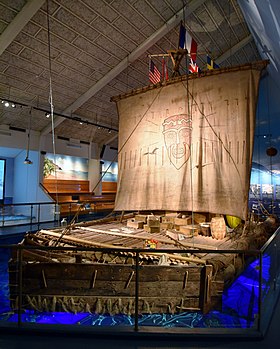The Kon-Tiki expedition was a 1947 journey by raft across the Pacific Ocean from South America to the Polynesian islands, led by Norwegian explorer and writer Thor Heyerdahl. The raft was named Kon-Tiki after the Inca god Viracocha, for whom "Kon-Tiki" was said to be an old name. Heyerdal's book on the expedition was entitled The Kon-Tiki Expedition: By Raft Across the South Seas. A 1950 documentary film won the Academy Award for Best Documentary Feature. A 2012 dramatized feature film was nominated for the Academy Award for Best Foreign Language Film.
The Kon-Tiki expedition was funded by private loans, along with donations of equipment from the United States Army. Heyerdahl and a small team went to Peru, where, with the help of dockyard facilities provided by the Peruvian authorities, they constructed the raft out of balsa logs and other native materials in an indigenous style as recorded in illustrations by Spanish conquistadores. The trip began on April 28, 1947. Heyerdahl and five companions sailed the raft for 101 days over 6,900 km (4,300 miles) across the Pacific Ocean before smashing into a reef at Raroia in the Tuamotus on August 7, 1947. The crew made successful landfall and all returned safely.
Heyerdahl believed that a sun-worshiping blond/red-haired and blue-eyed Caucasian people (whom he called the "Tiki people") from South America could have reached Polynesia during pre-Columbian times by drifting with the wind directions.[1][2] His aim in mounting the Kon-Tiki expedition was to show, by using only the materials and technologies available to those people at the time, that there were no technical reasons to prevent them from having done so. Although the expedition carried some modern equipment, such as a radio, watches, charts, sextant, and metal knives, Heyerdahl argued they were incidental to the purpose of proving that the raft itself could make the journey.
Heyerdahl's full hypothesis that a white race reached Polynesia before the Polynesian people is overwhelmingly rejected by research, even before the expedition. Heyerdahl also did not believe in the western origins of Polynesians, whom he believed were too primitive to sail against the wind and currents.[1][3] Archaeological, linguistic, cultural, and genetic evidence supports a western origin for Polynesians, from Island Southeast Asia, using sophisticated multihull sailing technologies and navigation techniques during the Austronesian expansion.[3][4][5] Although there is putative evidence of Polynesian contact with South America, it's more likely for Polynesians (who were already long-distance voyagers) to have been the ones to reach South America than the other way around.[6]
Thor Heyerdahl's book about his experience became a bestseller. It was published in Norwegian in 1948 as The Kon-Tiki Expedition: By Raft Across the South Seas, later reprinted as Kon-Tiki: Across the Pacific in a Raft. It appeared with great success in English in 1950, also in many other languages. A documentary motion picture about the expedition, also called Kon-Tiki, was produced from a write-up and expansion of the crew's filmstrip notes and won an Academy Award in 1951. It was directed by Heyerdahl and edited by Olle Nordemar. The voyage was also chronicled in the documentary TV-series The Kon-Tiki Man: The Life and Adventures of Thor Heyerdahl, directed by Bengt Jonson.[7]
The original Kon-Tiki raft is now on display in the Kon-Tiki Museum at Bygdøy in Oslo.
- ^ a b Cite error: The named reference
Holtonwas invoked but never defined (see the help page). - ^ Cite error: The named reference
Hermanwas invoked but never defined (see the help page). - ^ a b Cite error: The named reference
Arthurwas invoked but never defined (see the help page). - ^ Cite error: The named reference
Conniffwas invoked but never defined (see the help page). - ^ Cite error: The named reference
Wilfordwas invoked but never defined (see the help page). - ^ Gannon, Megan (8 July 2020). "DNA reveals Native American presence in Polynesia centuries before Europeans arrived". National Geographic. Retrieved 7 July 2024.
- ^ The Kon-Tiki Man episode breakdown Archived October 28, 2007, at the Wayback Machine

